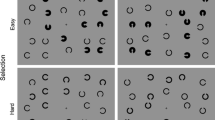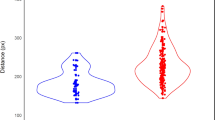Abstract
We examined the ability to use static line drawings of eye gaze cues to orient visual-spatial attention in children with high functioning autism (HFA) compared to typically developing children (TD). The task was organized such that on valid trials, gaze cues were directed toward the same spatial location as the appearance of an upcoming target, while on invalid trials gaze cues were directed to an opposite location. Unlike TD children, children with HFA showed no advantage in reaction time (RT) on valid trials compared to invalid trials (i.e., no significant validity effect). The two stimulus onset asynchronies (200 ms, 700 ms) did not differentially affect these findings. The results suggest that children with HFA show impairments in utilizing static line drawings of gaze cues to orient visual-spatial attention.


Similar content being viewed by others
References
American Psychiatric Association. (1994). Diagnostic and statistical manual of mental disorders (4th ed.). Washington: Author.
Bailey, A., Luthert, P., Dean, A., Harding, B., Janota, I., Montgomery, M., Rutter, M., & Lantos, P. (1998). A clinicopathological study of autism. Brain, 121, 889–905.
Baron-Cohen, S., Campbell, R., Karmiloff-Smith, A., Grant, J., & Walker, J. (1995). Are children with autism blind to the mentalistic significance of the eyes? British Journal of Developmental Psychology, 13, 379–398.
Bayliss, A. P., & Tipper, S. P. (2005). Gaze and arrow cueing of attention reveals individual differences among the autism spectrum as a function of target context. British Journal of Psychology, 96, 95–114.
Carper, R. A., & Courchesne, E. (2000). Inverse correlation between frontal lobe and cerebellum sizes in children with autism. Brain, 123, 834–844.
Chawarska, K., Klin, A., & Volkmar, F. (2003). Automatic attention cueing through eye movement in 2-year-old children with autism. Child Development, 74, 1108–1122.
Farroni, T., Johnson, M. H., Brockbank, M., & Simion, F. (2000). Infants’ use of gaze direction to cue attention: The importance of perceived motion. Visual Cognition, 7, 705–718.
Farroni, T., Mansfield, E. M., Lai, C., & Johnson, M. H. (2003). Infants perceiving and acting on the eyes: Tests of an evolutionary hypothesis. Journal of Experimental Child Psychology, 85, 199–212.
Friesen, C. K., & Kingstone, A. (1998). Covert and overt orienting to gaze direction cues and the effects of fixation offset. NeuroReport, 14, 489–493.
Geurts, H. M., Verte, S., Oosterlaan, J., Roeyers, H., & Sergeant, J. A. (2004). How specific are executive functioning deficits in attention deficit hyperactivity disorder and autism? Journal of Child Psychology and Psychiatry, 45, 836–854.
Girgis, R. R., Minshew, N. J., Melhem, N. M., Nutche, J. J., Keshavan, M. S., & Hardan, A. Y. (2007). Volumetric alterations of the orbitofrontal cortex in autism. Progress in Neuropsychopharmacology & Biological Psychiatry 31, 41–45.
Goldberg, M. C., Mostofsky, S. H., Cutting, L. E., Mahone, E. M., Astor, B. C., Denckla, M. B., & Landa, R. J. (2005). Subtle executive impairment in children with autism and children with ADHD. Journal of Autism and Developmental Disorders, 35, 279–293.
Hietanen, J. K., & Leppänen, J. M. (2003). Does facial expression affect attention orienting by gaze direction cues? Journal of Experimental Psychology Human Perception and Performance, 29, 1228–1243.
Hollingshead, A. B. (1975). Four factor index of social status. New Haven: Yale University, Department of Sociology.
Hood, B., Willen, J. D., & Driver, J. (1998). Adult’s eyes trigger shifts of visual attention in human infant. Psychological Science, 9, 131–134.
Hooker, C. I., Paller, K. A., Gitelman, D. R., Parrish, T. B., Mesulam, M. M., & Reber, P. J. (2003). Brain networks for analyzing eye gaze. Cognitive Brain Research, 17, 406–418.
Hughes, C., Russell, J., & Robbins, T. W. (1994). Evidence for executive dysfunction in autism. Neuropsychologia, 32, 477–492.
Kemper, T. L., & Bauman, M. (1998). Neuropathology of infantile autism. Journal of Neuropathology and Experimental Neurology, 57, 645–652.
Kingstone, A., Tipper, C., Ristic, J., & Ngan, E. (2004). The eyes have it!: An fMRI investigation. Brain and Cognition, 55, 269–271.
Kylliäinen, A., & Hietanen, J. R. (2004). Attention orienting by another’s gaze direction in children with autism. Journal of Child Psychology and Psychiatry, 45, 435–444.
Landa, R. J., & Goldberg, M. C. (2005). Language and executive functions in high functioning autism: A continuum of impaired to enhanced performance. Journal of Autism and Developmental Disorders, 35, 557–573.
Langton, S. R., & Bruce, V. (2000). You must see the point: Automatic processing of cues to the direction of social attention. Journal of Experimental Psychology Human Perception and Performance, 26, 747–757.
Le Couteur, A., Lord, C., & Rutter, M. (2003). The Autism Diagnostic Interview - Revised (ADI-R). Los Angeles: Western Psychological Services.
Leekam, S. R., Baron-Cohen, S., Perrett, D., Milders, M., & Brown, S. (1997). Eye-direction detection: A dissociation between geometric and joint attention skills in autism. British Journal of Developmental Psychology, 15, 77–95.
Lord, C., Risi, S., Lambrecht, L., Cook, E. H., Jr., Levanthal, B. L., DiLavore, P. C., Pickles, A., & Rutter, M. (2000). The autism diagnostic observation schedule-generic: A standard measure of social and communication deficits associated with the spectrum of autism. Journal of Autism and Developmental Disorders, 30, 205–223.
Lord, C., Rutter, M., & LeCouteur, A. (1994). Autism Diagnostic Interview-Revised: A revised version of a diagnostic interview for caregivers of individuals with possible pervasive developmental disorders. Journal of Autism and Developmental Disorders, 24, 659–685.
Mosconi, M. W., Mack, P. B., McCarthy, G., & Pelphrey, K. A. (2005). Taking an “intentional stance” on eye-gaze shifts: A functional neuroimaging study of social perception in children. NeuroImage, 27, 247–252.
Ohnishi, T., Matsuda, H., Hashimoto, T., Kunihiro, T., Nishikawa, M., Uema, T., & Sasaki, M. (2000). Abnormal regional cerebral blood flow in childhood autism. Brain, 123, 1838–1844.
Ozonoff, S. (1997). Components of executive function deficits in autism and other disorders. In J. Russell (Ed.), Autism as an executive disorder (pp.179–211). Oxford: Oxford Press.
Ozonoff, S., Cook, I., Coon, H., Dawson, G., Joseph, R. M., Klin, A., McMahon, W. M., Minshew, N., Munson, J. A., Pennington, B. F., Rogers, S. J., Spence, M. A., Tager-Flusberg, H., Volkmar, F. R., & Wrathall, D. (2004). Performance on Cambridge neuropsychological test automated battery subtests sensitive to frontal lobe function in people with autistic disorder: Evidence from the Collaborative Programs of Excellence in Autism network. Journal of Autism and Developmental Disorders, 34, 139–150.
Ozonoff, S., Pennington, B. F., & Rogers, S. J. (1991). Executive function deficits in high functioning autistic individuals: Relationship to theory of mind. Journal of Child Psychology and Psychiatry, 32, 1081–1105.
Pelphrey, K. A., Morris, J. P., & McCarthy, G. (2005). Neural basis of eye gaze processing deficits in autism. Brain, 128, 1038–1048.
Pelphrey, K. A., Singerman, J. D., Allison, T., & McCarthy, G. (2003). Brain activation evoked by perception of gaze shifts: The influence of context. Neuropsychologia, 41, 156–170.
Pennington, B. F., & Ozonoff, S. (1996). Executive functions and developmental psychopathology. Journal of Child Psychology and Psychiatry, 37, 51–87.
Posner, M. I. (1980). Orienting of attention. Quarterly Journal of Experimental Psychology, 32A, 3–25.
Posner, M. I. (1988). Structures and functions of selective attention. In: T. Boll & B. Bryant (Eds.), Master lectures in clinical neuropsychology (pp. 173–202). Washington: American Psychological Association.
Posner, M. I. (1990). Hierarchical distributed networks in the neuropsychology of selective attention. In Carramaza A (Eds.), Cognitive neuropsychology and neurolinguistics: Advances in models of cognitive function and impairment (pp. 187–210). New York: Plenum.
Posner, M. I., Cohen, Y., & Rafal, R. D. (1982). Neural systems control of spatial orienting. Philosophical Transactions of the Royal Society London B: Biological Science, 298, 187–198.
Reich, W., Welner, Z., & Herjanic, B. (1997). The diagnostic interview for children and adolescents-IV. North Tonawanda: Multi-Health Systems.
Ristic, J., Mottron, L., Friesen, C. K., Iarocci, G., Burack, J., & Kingstone, A. (2005). Eyes are special but not for everyone: The case of autism. Cognitive Brain Research, 24, 715–718.
Senju, A., Tojo, Y., Dairoku, H., & Hasegawa, T. (2004). Reflexive orienting in response to eye gaze and an arrow in children with and without autism. Journal of Child Psychology and Psychiatry, 45, 445–458.
Swettenham, J., Condie, S., Campbell, R., Milne, E., & Coleman, M. (2003). Does the perception of moving eyes trigger reflexive visual orienting in autism? Philosophical Translations of the Royal Society of London, 358, 325–334.
Vecera, S., & Johnson, M. H. (1995). Gaze detection and the cortical processing of faces: Evidence from infants and adults. Visual Cognition, 2, 59–87.
Vecera, S., & Rizzo, M. (2004). What are you looking at? Impaired ‘social attention’ following frontal-lobe damage. Neuropsychologia, 42, 1657–1665.
Vecera, S., & Rizzo, M. (2006). Eye gaze does not produce reflexive shifts of attention: Evidence from frontal lobe damage. Neuropsychologia, 44, 150–159.
Vlamings, P. H. J. M., Stauder, J. E. A., van Son, I. A. M., & Mottron, L. (2005). Atypical visual orienting to gaze- and arrow-cues in adults with high functioning autism. Journal of Autism and Developmental Disorders, 35, 267–277.
Wainwright-Sharp, J. A., & Bryson, S. E. (1993). Visual orienting deficits in high-functioning people with autism. Journal of Autism and Developmental Disorders, 23, 1–13.
Wechsler, D (1991). Wechsler intelligence scale for children third edition. San Antonio: The Psychological Corporation.
Wechsler, D. (2003). Wechsler intelligence scale for children fourth edition. San Antonio: The Psychological Corporation.
Zilbovicius, M., Garreau, B., Samson, Y., Remy, P., Barthélémy, C., Syrota, A., & Lelord, G. (1995). Delayed maturation of the frontal cortex in childhood autism. American Journal of Psychiatry, 152, 248–252.
Acknowledgments
This research was funded by the following grants: NIH Grants K01 MH 01824 (MCG), R01 NS048527 (SHM), K02 NS 044850 (SHM), HD024061 (Mental Retardation and Developmental Disabilities Research Center), M01 RR00052 (Johns Hopkins General Clinical Research Center); a grant from the National Alliance for Autism Research (SHM); and a National Science Foundation (NSF) award BCS 03-39171 (SPV). We would like to thank the participants and their parents for generously volunteering their time to participate in this study. We would like to thank Megan Roeder for her assistance in recruiting and screening participants for this project.
Author information
Authors and Affiliations
Corresponding author
Rights and permissions
About this article
Cite this article
Goldberg, M.C., Mostow, A.J., Vecera, S.P. et al. Evidence for Impairments in Using Static Line Drawings of Eye Gaze Cues to Orient Visual-Spatial Attention in Children with High Functioning Autism. J Autism Dev Disord 38, 1405–1413 (2008). https://doi.org/10.1007/s10803-007-0506-x
Received:
Accepted:
Published:
Issue Date:
DOI: https://doi.org/10.1007/s10803-007-0506-x




